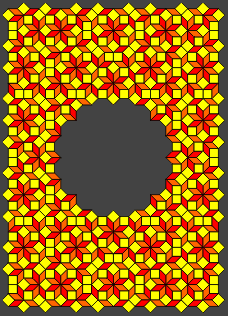

Click to read general information about afghans



Buy a pattern
for this afghan
on the order form
 Buy now
Buy now
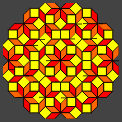


PENROSE
This is part of a well-
The design was sent to us by Sir Roger Penrose. It is named in his honour.
The first Penrose afghan was a red, yellow and orange version. It was bought by the London Science Museum for their Mathematics Collection.
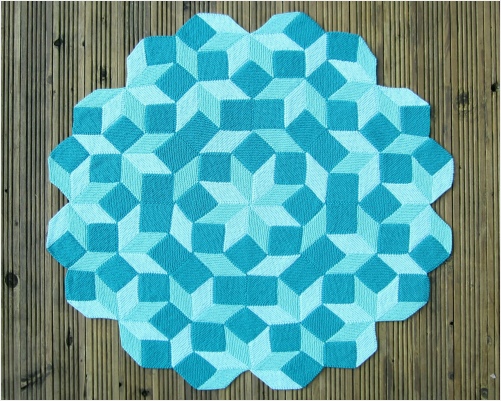
Aperiodic tilings do not repeat when moving across the surface. The section we chose to use does have rotation symmetry. It was extracted from a much larger design.
In February 1997, on hearing about our work with 45, 90 and 135 degree shapes, Sir Roger sent us a photocopy taken from a Japanese cloth, together with his own drawings explaining how this pattern occurs. He was then Rouse Ball Professor of Mathematics at Oxford University. The photocopy of the cloth was grey with the outlines of the shapes in white. Sir Roger had superimposed ‘stages of hierarchy’ of the design.
We added the colours and made the first afghan in the striking combination of red, yellow and orange. The Science Museum wanted to buy it even before it was complete. We made a more subtle version in three shades of turquoise to show the different effects colour can create. The Science Museum had the choice of the two and chose the more vibrant version.
The cushion uses an even smaller section of the tiling which could possibly have come from several other pattern sources.
Penrose Tilings use shapes with other angles but they were outside the rules we were using.

Scroll down for more information about
Penrose

RELATED DESIGNS
TESSELLATION AFGHANS
CUSHION

CONSTRUCTION INFORMATION
The squares are knitted first.
Wherever possible, stitches are picked up from existing pieces to make the other shapes.
It is completed in eight sections which are then stitched together.

KNITTING INFORMATION
Use any yarn and needles of your choice. Three colours are required. Subtle toning shades are likely to give a more 3D effect whereas contrasting colours may make the design more obvious.
The pattern includes instructions for changing the size of the pieces to change the overall size of the afghan.
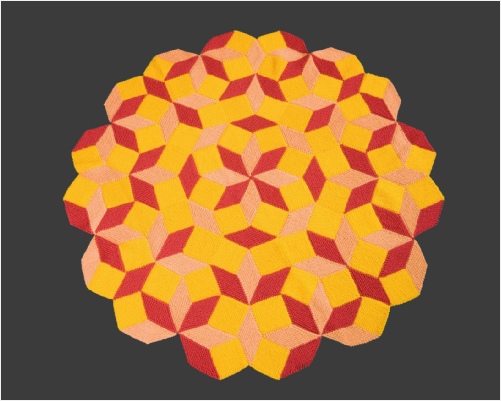
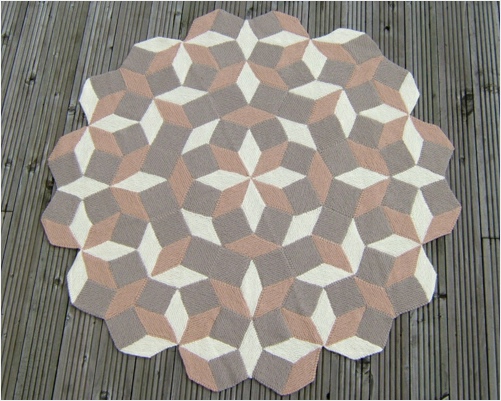

This version was made by my mother, Maisie. She was very good at dressmaking, and other sewing but wasn't really much of a knitter.
When we started designing modular knitwear, she became addicted to it, as many people are. Finishing a garment was no problem. Completing one small piece seemed to be a spur to go on and make more.
Our original Penrose cushion was made in colours to match her lounge and very soon afterwards she decided to make her own afghan version, which she completed with lightning speed. She always kept it to hand and frequently snuggled under it.
For several years, Maisie helped out at various exhibitions. She would not get involved in mathematical conversations but would enthusiastically discuss the knitting, saying, 'If I can do it, anyone can!'
£1 from the sale of each Penrose pattern is donated to Kidney Research UK
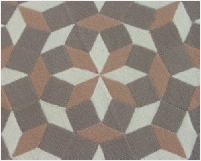
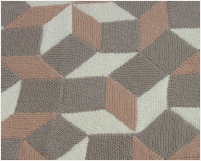
Click to see
larger pictures
